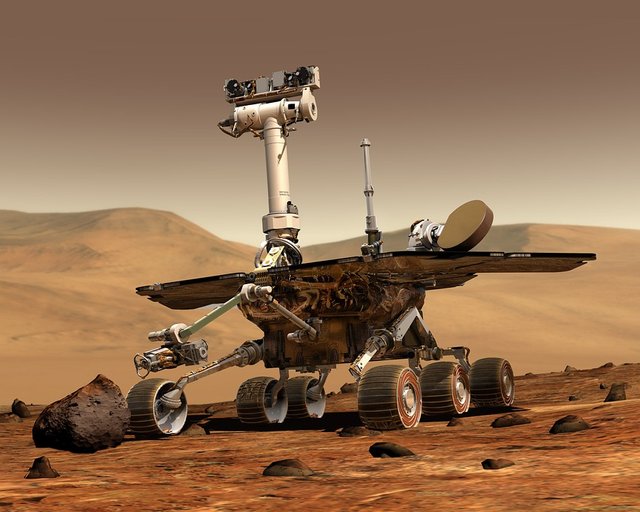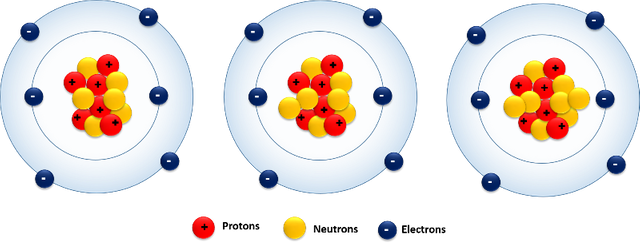Since 2012 the Curiosity rover sent by NASA to Mars to explore its surface, has been exploring a crater called Gale, located on the surface of the planet Mars, since then it has sent to earth numerous data that are analyzed by scientists. But among all the data sent, the one that has caused most intrigue to scientists is the presence of carbon isotopes in more than half a dozen places that the rover has explored.

NASA's Curiosity rover has sent back samples with an intriguing carbon signature. Source: pixabay.com.
Although carbon is one of the most reliable elements used by scientists to determine the presence of life, it can also originate in other ways. And in this regard, in a study recently published in the journal Proceedings of the National Academy of Sciences, a group of researchers made up of scientists from NASA and several U.S. universities have proposed three possible explanations for the origin of carbon on Mars; they refer that any of the three scenarios is possible, but they are unconventional and different from any process known here on Earth.
Carbon isotopes
By definition, isotopes are atoms of the same element whose nucleus contains the same number of protons but differ in the number of neutrons, and therefore differ in the mass number.
That is to say, if we take for example the most abundant hydrogen atom, which has in its nucleus only one proton and one neutron, and we add another neutron, it becomes an isotope of the same atom (called deuterium), but if we add another proton it becomes a different atom, helium.
There are three naturally occurring isotopes of carbon: carbon 12 (6 protons and 6 neutrons), carbon 13 (6 protons and 7 neutrons), and the radioactive isotope carbon 14 (6 protons and 8 neutrons).

Carbon isotopes. Source: image elaborated in Powerpoint.
The 12C and 13C isotopes are the most stable and abundant (98.9% and 1.07% respectively), while traces of the 14C isotope are found and it is unstable, decaying radioactively. And by observing the proportions between the isotopes in a given sample, information can be deduced about the carbon cycle that produced it, and even its age can be established, since carbon 12 reacts faster than carbon 13, and carbon 14 decays at a constant rate.
Carbon on Mars
The Curiosity rover has spent 9 years exploring the Gale Crater, an area of interest to scientists because it has uncovered very old rock layers. The rover has taken samples several centimeters deep, which have been analyzed by spectrographic analysis of the carbon released by heating the samples, the results have revealed a wide variety in the ratio of carbon 12 and 13, some samples were very poor in carbon 13 while others were found to be very rich in this isotope.

This self-portrait of NASA Curiosity Mars rover shows the vehicle at a drilled sample site called Okoruso. Source: picryl.com.
On Earth, sediment samples in which very low amounts of carbon 13 have been found come from billions of years ago, at a stage on Earth when methane was consumed by ancient microbial colonies. But the planet Mars did not have the same formation process as the earth, so they may not necessarily have the same explanation.
The three theories that could explain the presence of samples with low carbon 13 content.
- Cosmic dust: Dust, fine particles that can be less than a fraction of a micrometer, can be found in space, and much of it reaches the earth and other planets in the solar system. This dust, depending on its origin, from stars, comets or asteroids, may contain simple organic compounds in its composition. According to the research, our solar system goes through a galactic dust cloud every 200 million years, but this event does not deposit much dust, and to create the layer of dust detected by the rover, Mars would have had to have large glaciers to trap that dust, and once they melted, leave that layer of dust on the surface.
But this is unlikely because there is no evidence of large glaciers on Mars, at least this hypothesis requires further investigation.
Ultraviolet conversion of CO2: The second explanation for the low amounts of carbon-13 is the ultraviolet conversion of carbon dioxide into simple organic compounds, such as formaldehyde, then these compounds could have been washed by rain to the surface, where they accumulated and left this carbon footprint. Although this is a possible process, more data are needed to prove it.
Biological basis: in comparison with carbon-13 depleted samples taken on Earth, it was hypothesized that microbes from the Martian past consumed methane that was released into the atmosphere from the subsurface, but the data have not shown records of past surface microbes, and therefore more evidence is needed.
As we can see, the three theories put forward to explain the presence of this carbon signature found by the Curiosity rover are possible, but they need more data to corroborate any of them and to be able to give an answer that explains where this carbon comes from, because undoubtedly, its origin does not resemble any carbon cycle like the one that occurs on Earth.
And while scientists continue to debate where the Martian carbon comes from, the Curiosity rover, the predecessor to Perseverance, continues to roam the surface of the red planet looking for more clues to help scientists elucidate whether microbial life existed in our neighboring planet's distant past.
Thanks for coming by to read friends, I hope you liked the information. See you next time.

Wow this is something interesting topic regarding the carbon dioxide. I never know about the fact that you have told regarding the Mars.
Mars is the most influential planets which every country is looking to explore. I have heard that life also found on Mars but that is all bacteria etc.
Downvoting a post can decrease pending rewards and make it less visible. Common reasons:
Submit
Hello @emiliomoron, The two theories that most capture my attention are the possible existence of glaciers and the possible existence of "biological entities", because as far-fetched and fanciful as it may seem, they seem very likely and really make me very curious, because this would be the best proof of "existence of life" on the red planet.
Downvoting a post can decrease pending rewards and make it less visible. Common reasons:
Submit
Hi @tocho2, there is certainly a lot of intrigue in the subject, all theories are valid according to the evidence, perhaps the scientists are trying to be cautious with relating the evidence to the existence of life on Mars, we will continue with the intrigue until there is more data to confirm any of the theories.
Downvoting a post can decrease pending rewards and make it less visible. Common reasons:
Submit
This is really an interesting one, it is amazing how much much research is going on and the discovery of how much nature is endowed is indeed mind blowing, nice job buddy. Thanks for putting this one out here for us to benefit from.
Downvoting a post can decrease pending rewards and make it less visible. Common reasons:
Submit
Hello friend, thanks to you for reading, it is really amazing what is being done in space exploration, no doubt we will be amazed by new discoveries. Greetings.
Downvoting a post can decrease pending rewards and make it less visible. Common reasons:
Submit